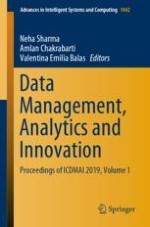2020 | Book
Data Management, Analytics and Innovation
Proceedings of ICDMAI 2019, Volume 1
Editors: Prof. Neha Sharma, Dr. Amlan Chakrabarti, Prof. Valentina Emilia Balas
Publisher: Springer Singapore
Book Series : Advances in Intelligent Systems and Computing
